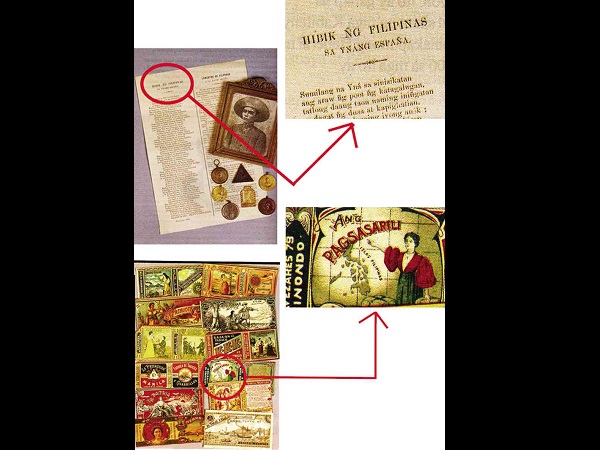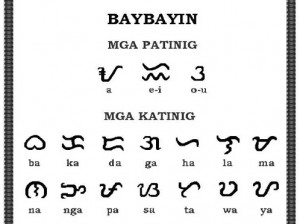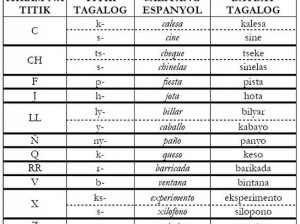From ‘Pilipinas’ to ‘Filipinas’

“HIBIK ng Filipinas” is the poem by Katipunan Supremo Andres Bonifacio, an example of the use of Filipinas to refer to the country. Bonifacio led the Philippine Revolution against Spain in 1896.
“ANG PAGSASARILI” is a brand of cigarette in the 1920s during the American period, another example of the use of Filipinas to refer to the country while struggling for independence.
Photos courtesy of The Commission on the Filipino Language
1 WHY go back to “Filipinas?”
There are three reasons behind the Board of Commissioners Resolution No. 13-19 (April 12, 2012) of the Commission on the Filipino Language or Komisyon sa Wikang Filipino (KWF):
First, history. There are now three forms of the name of our country.
Filipinas, the name given by Ruy López de Villalobos in 1548 and used officially by Miguel López de Legazpi when he established the Spanish colony beginning 1565, which was used continuously for 300 years until the time of Rizal and Bonifacio, and again used as the name of the first Asian republic—the “Republica Filipinas” established in Malolos in 1898.

Pre-Hispanic alphabet and sounds
Source: “Ortograpiyang Pambansa.” Edisyon 2013. Komisyon sa Wikang Filipino
“Philippines,” the name used by the Americans when they entered our country in 1898 and officially used by the Constitution of 1936 and up to the current Constitution of 1987.
“Pilipinas,” used starting around 1941 when the abakada without the F was promoted for general usage and continued as the translation of Filipinas and Philippines in works and documents written in the Pilipino language (which was the name given in 1959 to the national language using the abakada).
Second, language change and development. In the 1973 Constitution, it was stated that “Filipino” instead of Pilipino should be the name of the national language.
This was restated in the 1987 Constitution, together with the proposed modernization and enrichment of the national language by way of the native languages.
The first step in this language change was the eschewing of the abakada and the promotion and spread of the alpabeto with the additional letters C, F, J, Ñ, Q, V, X and Z.
Now that the national language has an F and is called Filipino, isn’t it simply logical to restore Filipinas and gradually discourage the use of Pilipinas?
Third, to be consistent with the method of using the eight additional letters in the Ortograpiyang Pambansa (National Orthography) being promoted by the KWF.
This is the first comprehensive examination of the new alphabet and should be read closely by users of the the Filipino language and other native languages.
The case of Filipinas is an application of the letter F in borrowed proper nouns.
According to the Rule 4.6 in the document:
“Borrowing with the Use of the 8 New Letters. At present, therefore, all the eight borrowed letters in the new alphabet are used in three instances of borrowing from foreign languages.
“First, in proper nouns borrowed from foreign languages, such as Charles, Ceferino, Catherine, Colorado, Fidel, Feliza, San Fernando, Filipinas, Jason, Jennifer, St. Joseph, Jupiter, Beijing, Niñez, Montaño, Santo Niño, Enrique, Quiroga, Quirino, Vicente, Vladimir, Nueva Vizcaya, Vancouver, Xerxes, Maximo, Mexico, Zenaida, Zion, Zobel and Zanzebar.
Second, in scientific and technical terms, such as “carbong dioxide,” “Albizia falcataria,” “jus sanguinis,” “quorum,” “quo warranto,” “valence,” “x-axis,” “oxygen,” “zeitgeist,” “zero” and “zygote.”

Borrowed letters, Tagalog equivalents and word examples
Source: “Ortograpiyang Pambansa.” Edisyon 2013. Komisyon sa Wikang Filipino
Third, in words that cannot be respelled easily, such as cauliflower, flores de mayo, jaywalking, queen, quiz, mix, pizza and zebra.
2 If that is the case, should words borrowed from the Spanish with the letter F and already respelled with P revert to F?
It is in fact clearly disallowed under Rule 4.2 of Ortograpiyang Pambansa and considered a waste of time. Instead, the new letters like F should be used only in words sourced from native languages with such sounds and in new borrowings from foreign languages, such as “fosil” from Spanish or “fern” from English, or scientific and technical words such as “formaldehyde.”
3 Is it also necessary to respell into Filipinas the names of institutions and organizations currently spelled as Pilipinas?
It is not necessary. It is stated in the third paragraph of Resolution No. 13-19 of the KWF that the shift for institutions and organizations with Pilipinas in their name is not compulsory.
Although they will be encouraged to shift, it is their option to maintain their present name and be part of the history of the language as representing the time when the abakada was in use.
The implementation of the KWF resolution is expected for new groups to be named and organized in the future.
4 Should “Unibersidad ng Pilipinas” be made into “Unibersidad ng Filipinas?”
As in the answer to the previous question, it is not necessary to change the name of Unibersidad ng Pilipinas. It will be up to the the UP constituency.
Neither does the resolution affect the initials “UP” because these are in English and are derived from the English name “University of the Philippines.”
That’s why the initials are pronounced “Yoo Pee.” If these were in Pilipino, they would be pronounced “Oo Pah.”
5 Should “Pinas” be changed into “Finas” and “Pinoy” into
“Finoy?”
It is not necessary. “Pinas” is derived from the third and fourth syllables, which are “FiliPINAS” and “Pinoy” is in turn only derived from “Pinas.” That’s why this is not affected by the proposed restoration of “Filipinas” from “Pilipinas.”
6 Isn’t this project too expensive for an impoverished country?
As stated in the KWF resolution, the change will be implemented gradually.
For example, letterheads, books and other documents with Pilipinas on them will change only when supplies run out, and new editions and printing become necessary.
The country’s currency and bank notes (coins and paper money) will have the word “Filipinas” on them only when the Bangko Sentral issues new money.
It is possible that the very first expense on the shift will be incurred for the Seal of the President and it will not cost over a hundred thousand pesos.
7 Why is the KWF intervening in the way the country’s name
is spelled?
It is part of the mandate and function of KWF under Republic Act No. 7104 in pursuit of the provision of the 1987 Constitution that:
“Congress shall create a Commission on the National Language composed of representatives of the different regions and disciplines that shall conduct, coordinate and support researches for the development, promotion, and maintenance of Filipino and other languages.”
According to RA 7104, it is the function of the KWF to formulate policies and programs to promote and enrich Filipino as well as the rules in the pursuit of these policies and programs.
The case of Filipinas is part of the general reform in the use of Filipino as outlined in Ortograpiyang Pambansa.
In addition, this case is only one of the many problems that must be addressed in relation to the creation of an Atlas Filipinas—a geographic dictionary that is very necessary and needs to be done soon in order to fix the spelling of the place names, municipalities, provinces and regions in the whole country.
8 Isn’t Filipinas symbolic of colonial mentality?
Maybe true because it is derived from the name of King Philip of Spain. But it is also a symbol of the linkage and union of the barangay, tribes and islands of our archipelago.
Before Filipinas, what Legazpi referred to as Indios were a disjointed, scattered lot. He colonized us but also gave us a first means toward national unity.
On the other hand, it is rather difficult to say that just calling our country Pilipinas is already nationalistic. This happened merely because of the abakada.
Did the meaning of Filipinas change because the P was made into F? Similarly, did the Spanish “forma” change meaning because it was spelled as “porma”?
Truth is, Pilipino—the name of the language corresponding to Pilipinas—was rejected during the 1970s because, like the abakada, it carried a Tagalog memory.
Pilipino was replaced with Filipino for the latter to symbolize the modern nationalistic aspiration.
The alphabet with the eight additional Filipino letters is reflective of the aim to include and involve the native languages of the country, which had been deprived of participation in the abakada of Pilipino of a country called Pilipinas.
It is more from such a vision of the Filipino that the proposal of the KWF to recover the spelling of Filipinas originates.
9 Why won’t the KWF think of a new name for the country?
Why not, indeed? But this is not the function of the KWF and is outside the scope of the Ortograpiyang Pambansa.
This will need a different and meaningful rationale, which might be more nationalistic, but will definitely need an act of Congress and of the President of the Philippines. The KWF will accede to whatever proposal wins as a new name for our Filipinas.















